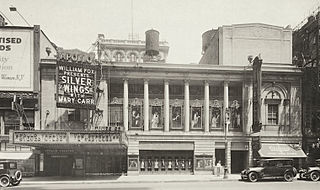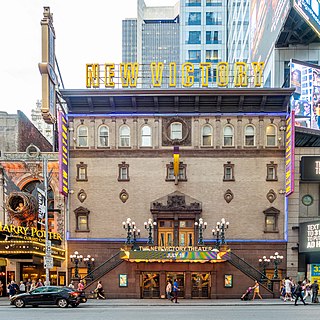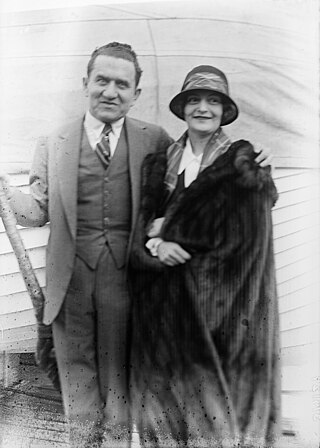
A grindhouse or action house is an American term for a theatre that mainly shows low-budget horror, splatter, and exploitation films for adults. According to historian David Church, this theater type was named after the "grind policy", a film-programming strategy dating back to the early 1920s which continuously showed films at cut-rate ticket prices that typically rose over the course of each day. This exhibition practice was markedly different from the era's more common practice of fewer shows per day and graduated pricing for different seating sections in large urban theatres, which were typically studio-owned.

The New Amsterdam Theatre is a Broadway theater at 214 West 42nd Street, at the southern end of Times Square, in the Theater District of Manhattan in New York City. One of the first Broadway venues to open in the Times Square neighborhood, the New Amsterdam was built from 1902 to 1903 to designs by Herts & Tallant. The theater is operated by Disney Theatrical Productions and has 1,702 seats across three levels. Both the Beaux-Arts exterior and the Art Nouveau interior of the building are New York City landmarks, and the building is on the National Register of Historic Places.

The Lyric Theatre is a Broadway theater at 214 West 43rd Street in the Theater District of Midtown Manhattan in New York City. Opened in 1998, the theater was designed by Richard Lewis Blinder of Beyer Blinder Belle, in collaboration with Peter Kofman, for Garth Drabinsky and his company Livent. The Lyric Theatre was built using parts of two former theaters on the site: the Apollo Theatre, built in 1920 to a design by Eugene De Rosa, and the old Lyric Theatre, built in 1903 to a design by Victor Hugo Koehler. The theater contains 1,622 seats across three levels and is operated by Ambassador Theatre Group (ATG). The theater building is owned by the city and state governments of New York and was developed by New 42nd Street.

The American Airlines Theatre, originally the Selwyn Theatre, is a Broadway theater at 227 West 42nd Street in the Theater District of Midtown Manhattan in New York City. Built in 1918, it was designed by George Keister and developed by brothers Edgar and Archibald Selwyn, for whom the theater was originally named. The theater is owned by the city and state governments of New York and leased to New 42nd Street. It has 740 seats across two levels and is operated by Roundabout Theatre Company. Since 2000, the theater has been named for American Airlines (AA), which bought the theater's naming rights.

The Times Square Theater is a former Broadway and movie theater at 217 West 42nd Street in the Theater District of Midtown Manhattan in New York City, near Times Square. Built in 1920, it was designed by Eugene De Rosa and developed by brothers Edgar and Archibald Selwyn. The building, which is no longer an active theater, is owned by the city and state governments of New York and leased to New 42nd Street.
Minsky's Burlesque refers to the brand of American burlesque presented by four sons of Louis and Ethel Minsky: Abraham 'Abe' Bennett Minsky (1880–1949), Michael William 'Billy' Minsky (1887–1932), Herbert Kay Minsky (1891–1959), and Morton Minsky (1902–1987). They started in 1912 and ended in 1937 in New York City. Although the shows were declared obscene and outlawed, they were rather tame by modern standards.

The Lyric Theatre was a Broadway theatre built in 1903 in the Theater District of Manhattan in New York City. It had two formal entrances: at 213 West 42nd Street and 214-26 West 43rd Street. In 1934, it was converted into a movie theatre which it remained until closing in 1992. In 1996, its interior was demolished and the space was combined with that of the former Apollo Theatre to create the Ford Center, now the new Lyric Theatre. Both the 42nd and 43rd Street facades of the original Lyric were preserved and today form the front and back entrances of the modern Lyric Theatre.

The New Victory Theater is a theater at 209 West 42nd Street in the Theater District of Midtown Manhattan in New York City, near Times Square. Built in 1900 as the Republic Theatre, it was designed by Albert Westover and developed by Oscar Hammerstein I as a Broadway theater. The theater has been known by several names over the years, including the Belasco Theatre, Minsky's Burlesque, and the Victory Theatre. The theater is owned by the city and state governments of New York and leased to nonprofit New 42nd Street, which has operated the venue as a children's theater since 1995. The New Victory presents theater shows, dance shows, puppet shows, and other types of performance art shows from all around the world.

The 44th Street Theatre was a Broadway theater at 216 West 44th Street in the Theater District of Manhattan in New York City from 1912 to 1945. It was originally named Weber and Fields' Music Hall when it opened in November 1912 as a resident venue for the comedy duo Weber and Fields, but was renamed to the 44th Street Theatre in December 1913 after their tenure at the theatre ended. It should not be confused with the Weber and Fields' Broadway Music Hall, often referred to as simply Weber and Fields' Music Hall and also known as Weber's Music Hall or Weber's Theatre, which was used by both Weber and Fields or just Weber from 1896 through 1912.

The Liberty Theatre is a former Broadway theater at 234 West 42nd Street in the Theater District of Midtown Manhattan in New York City. Opened in 1904, the theater was designed by Herts & Tallant and built for Klaw and Erlanger, the partnership of theatrical producers Marc Klaw and A. L. Erlanger. The theater has been used as an event venue since 2011 and is part of an entertainment and retail complex developed by Forest City Ratner. The theater is owned by the city and state governments of New York and leased to New 42nd Street. Brookfield Asset Management, which acquired Forest City in 2018, subleases the venue from New 42nd Street.

Oliver Morosco was an American theatrical producer, director, writer, film producer, and theater owner. He owned the Morosco Photoplay Company. He brought many of his theater actors to the screen. Frank A. Garbutt was in charge of the film business. The company was merged with Adolph Zukor's Famous Players–Lasky Corporation in 1916.

New 42 is a not-for-profit organization based in Manhattan, New York City. In 1990, the New 42nd Street was formed to oversee the redevelopment of seven neglected and historic theatres on 42nd Street between Seventh and Eighth Avenues, and to restore the block to a desirable tourist destination in Manhattan. The theatres were the Apollo Theatre, the Empire Theatre, the Liberty Theatre, the Lyric Theatre, the Selwyn Theatre, the Times Square Theatre, and the Victory Theater.

George W. Keister was an American architect. His work includes the Hotel Gerard (1893), the Astor Theatre (1906), the Belasco Theatre (1907), the Bronx Opera House (1913), the Apollo Theater in Harlem (1914), the Selwyn Theatre, and the First Baptist Church in the City of New York. He also designed Woodbridge Hall at 431 Riverside Drive (1901), which faced demolition in 1996, and the Sigma Chi Fraternity at 565 W. 113th St. (1903).

The Empire Theatre is a former Broadway theater at 234 West 42nd Street in the Theater District of Midtown Manhattan in New York City. Opened in 1912, the theater was designed by Thomas W. Lamb for the Hungarian-born impresario A. H. Woods. It was originally named for female impersonator Julian Eltinge, a performer with whom Woods was associated. In 1998, the building was relocated 168 feet (51 m) west of its original location to serve as the entrance to the AMC Empire 25, a multiplex operated by AMC Theatres, which opened in April 2000.

Archibald Selwyn was a Canadian-American play broker, theater owner and stage producer who had many Broadway successes. He and his brother Edgar Selwyn were partners. They were among the founders of Goldwyn Pictures, later to be merged into MGM.

The Columbia Theatre was an American burlesque theater on Seventh Avenue at the north end of Times Square in Midtown Manhattan, New York City. Operated by the Columbia Amusement Company between 1910 and 1927, it specialized in "clean", family-oriented burlesque, similar to vaudeville. Many stars of the legitimate theater or of films were discovered at the Columbia. With loss of audiences to cinema and stock burlesque, the owners began to offer slightly more risqué material from 1925. The theater was closed in 1927, renovated and reopened in 1930 as a cinema called the Mayfair Theatre. It went through various subsequent changes and was later renamed the DeMille Theatre. Nothing is left of the theater.

The Anco Cinema was a former Broadway theatre turned cinema at 254 West 42nd Street, between 7th and 8th Avenues in Manhattan, New York City. It opened in 1904 and was originally named the Lew Fields Theatre. It continued to operate as a playhouse under various names until it was converted into a movie theatre in 1930. Its block was famous for its concentration of Broadway theatres turned cinemas. After World War II, the street declined and the Anco Cinema eventually became a pornography venue. It closed as a cinema in 1988 and was gutted for retail use. The building was demolished in 1997.

Village East by Angelika is a movie theater at 189 Second Avenue, on the corner with 12th Street, in the East Village of Manhattan in New York City. Part of the former Yiddish Theatre District, the theater was designed in the Moorish Revival style by Harrison Wiseman and built from 1925 to 1926 by Louis Jaffe. In addition to Yiddish theatre, the theater has hosted off-Broadway shows, burlesque, and movies. Since 1991, it has been operated by Angelika Film Center as a seven-screen multiplex. Both the exterior and interior of the theater are New York City designated landmarks, and the theater is on the National Register of Historic Places.

The Mutual Burlesque Association, also called the Mutual Wheel or the MBA, was an American burlesque circuit active from 1922 until 1931. Controlled by Isidore Herk, it quickly replaced its parent company and competitor, the Columbia Amusement Company, as the preeminent burlesque circuit during the Roaring Twenties. Comedians Bud Abbott, Lou Costello, Harry Steppe, Joe Penner, Billy Gilbert, Rags Ragland, and Billy Hagan, as well as stripteasers Ann Corio, Hinda Wausau, Gypsy Rose Lee, and Carrie Finnell, performed in Mutual shows. Mae West appeared in Mutual shows from 1922 to 1925. Mutual collapsed during the Great Depression.

The Sam H. Harris Theatre, originally the Candler Theatre, was a theater within the Candler Building, at 226 West 42nd Street, in the Theater District of Midtown Manhattan in New York City. Opened in 1914, the 1,200-seat theater was designed by Thomas W. Lamb and built for Asa Griggs Candler, who leased it to George M. Cohan, Sam H. Harris, and George Kleine. Although the theater was intended to host both movies and legitimate Broadway productions, it functioned exclusively as a movie theater after 1933. The theater's auditorium was demolished by 1998. The only remnant of the former theater is its 42nd Street facade, which has been used by the Madame Tussauds New York museum since 2000.



















